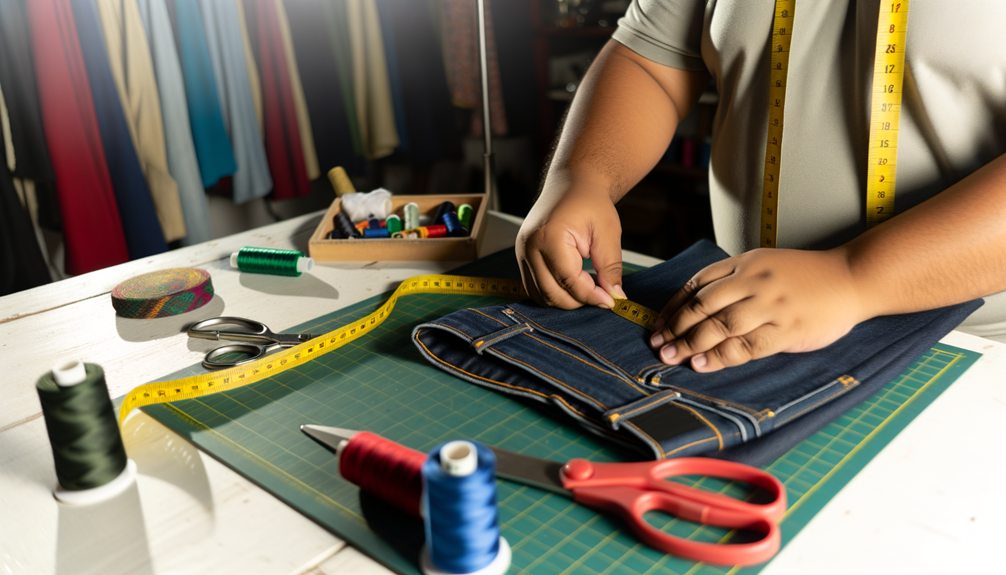You might not realize that an accurate inseam measurement can differ depending on whether you measure pants or your body directly. It’s a detail that can make a significant difference in how your clothes fit and feel. To measure your inseam correctly, you’ll need to determine which method suits your needs best. Whether you’re using pants that fit you well or taking a direct body measurement, there’s more to reflect on than just the length. Stick around to discover the nuances of each method and how to guarantee your measurements are spot-on every time.
Understanding Inseam Basics
Understanding the inseam is vital for finding pants that fit well and look great. To achieve this, you need an accurate inseam measurement, which is the distance from the crotch to the leg opening. This measurement is significant because it guarantees your pants’ leg length matches your body, providing both comfort and style.
Inseam lengths typically range from 21 to 36 inches, depending on the wearer’s height and the style of pants, such as straight-leg, skinny, or cropped.
For an accurate inseam measurement, use a flexible measuring tape and decide whether to measure directly on your body or use a pair of well-fitting pants. If measuring on yourself, stand straight and start from your upper inner thigh down to your ankle, keeping the tape flush against your skin. This guarantees you capture the true leg length needed for pants that fit well.
Different styles may require different inseam lengths, so knowing your measurement helps you select the right fit, reducing the need for alterations.
Using Pants for Measurement
When measuring your inseam using pants, start by finding a pair that fits you well and matches the style of pants you plan to buy. This step is essential since inseam lengths can vary between different styles.
Lay the pants flat on a smooth surface, making sure they’re wrinkle-free. Use a flexible measuring tape and measure from the crotch seam to the hem of the pant leg along the inner seam. This gives you the inseam length.
Accuracy is key, so make certain the tape lies flat against the fabric without stretching or sagging. If the pants are prone to shrinking, consider adding an extra 0.5 to 1 inch to accommodate any changes after washing. This simple adjustment guarantees your new pants will still have a perfect fit even after a wash.
Keep this inseam length recorded for future reference, making your shopping experience more efficient. Having this measurement handy allows you to select pants that fit perfectly without the hassle of alterations.
Body Measurement Technique
For an accurate inseam measurement directly on your body, start by standing straight with your feet shoulder-width apart. Wear fitted pants to avoid any bulky material interfering with the measurement. Grab a flexible measuring tape, as it will help contour the inner leg seam accurately.
Begin by placing the tape at the upper inner thigh, right at the crotch seam. Extend the tape down your leg until you reach the desired hem length at the ankle.
It’s essential to perform inseam measurements barefoot, guaranteeing the right length is achieved without interference from shoes, which can alter the measurement. To achieve the most precise results, consider having a friend assist. They can hold the measuring tape at the starting point while you stand still. This helps to avoid any movements that might affect the length.
When measuring a pair of pants, remember to record the inseam length precisely without rounding. This precision assures you have the right measurement for both shopping and tailoring purposes.
Ensuring Accurate Results
To guarantee accurate inseam measurements, focus on maintaining a consistent method. Start by wearing fitted pants and standing straight to prevent any material from affecting your results. When you measure the length, use a flexible measuring tape, making sure one end sits firmly at the crotch seam and extends straight down the inside of your leg to the desired hemline. This helps you find the perfect length for your inseam number.
For precision, have someone assist you. They can help keep your posture in check and make certain the tape runs perfectly along the inside of your leg. Double-checking is essential—measure multiple pairs of well-fitting pants and average out the numbers to confirm you’ve got a reliable inseam number. This will help verify that your measuring technique is consistent and accurate.
Consider the context of how you’ll wear the pants. If you plan on wearing heels or anticipate fabric shrinkage from washing, adjust the inseam length by adding about 0.5 to 1 inch. This small adjustment can make a significant difference in achieving the perfect length.
Applying Your Inseam Measurement

Start using your inseam measurement to streamline your shopping experience and find pants that fit just right. With your inseam in hand, you can confidently browse through online stores, selecting the right size to guarantee a perfect fit and minimize returns.
By comparing your inseam measurement against the size charts provided by each brand, you’ll be able to identify the most suitable options—keeping in mind that styles like straight-leg jeans often require inseams from 27 to 36 inches, while cropped styles may need 21 to 30 inches.
When shopping, it’s vital to take into account the style and fit you prefer. For tailored pants or custom clothing, your inseam measurement is fundamental to achieve the desired length and fit. Remember to inform the tailor of your specific inseam to confirm the final product meets your expectations.
Additionally, if you plan to wear particular footwear, adjust your inseam measurement by about 0.5 to 1 inch to accommodate heel height or potential fabric shrinkage. This simple step can greatly influence how your pants will look and feel.
Frequently Asked Questions
How Do I Measure My Inseam at Home?
To measure your inseam at home, stand straight and use a flexible measuring tape. Measure from your crotch seam down to your ankle, keeping the tape flush against your skin.
Wear close-fitting pants or leggings to guarantee accuracy, avoiding bulky materials. If you need precision, have someone help hold the tape at the crotch while you stand.
Alternatively, measure a well-fitting pair of pants by laying them flat and measuring the inner seam.
Do You Measure Inseam to Ankle or Floor?
You should measure your inseam to the ankle for most styles, which guarantees pants fit at ankle length.
Measure from your crotch seam down to your ankle bone. If you’re measuring for cropped or shorter styles, adjust the inseam accordingly.
Measuring to the floor is typically reserved for custom or tailored pants. Always measure without shoes for accuracy, and use the same point of reference to compare different pant styles effectively.
What Should My Inseam Be for My Height?
Imagine a world where pants are always the right length—what a dream!
For your height, you’re aiming for an inseam that complements your stance. If you’re 5’0″ to 5’3″, a 28-inch inseam might fit just right.
At 5’4″ to 5’6″, consider a 30-inch inseam. Heights of 5’7″ to 5’9″ often pair well with 32 inches, while 5’10” to 6’1″ find 34 inches ideal.
What Is My Inseam if I’m 5’3″?
If you’re 5’3″, your inseam typically ranges from 27 to 30 inches, though it can vary based on style preferences.
For cropped pants, aim for an inseam between 21 to 25 inches.
Straight-leg jeans usually need a 28 to 30-inch inseam to fit well without bunching.
Remember, the rise of the pants also affects the fit, so take that into account.
Always check the brand’s size chart for precision.
Conclusion
Now that you know how to measure your inseam, you’re just steps away from perfect-fitting pants. Whether you use your favourite pair of pants or measure directly on your body, accuracy is key. Don’t forget to account for shrinkage by adding a little extra length. With these precise measurements, you’ll confidently choose pants that fit just right, every time. So, grab that measuring tape and get ready for a wardrobe upgrade you won’t regret!


